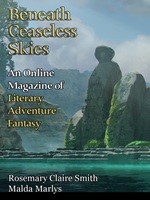 Beneath Ceaseless Skies #437, July 24, 2025
Beneath Ceaseless Skies #437, July 24, 2025
“Songs for Obsidian” by Rosemary Claire Smith
“Woman Like Stone Like Water” by Malda Marlys
Reviewed by Axylus
This issue features two stories in which characters form unlikely bonds.
In “Songs for Obsidian” by Rosemary Claire Smith, the evil mage Keraunion has captured Tripodea, a female being made of obsidian who has three eyes and three feet; and Vento, a singing sea creature that resembles an agile cetacean. Tripodea’s twelve brothers and two sisters were captured as well, but they do not respond to her calls, apparently dead. All of the stone beings were dismembered and shaped into a great, immobile wall by Keraunion, while Vento was imprisoned in a large blue lake below. Keraunion then left them there for millenia, and a human civilization grew up around them.
Despite the fundamental contrasts between land and sea, Tripodea and Vento form a relationship that spans their captivity, as Vento’s songs sustain Tripodea. Keraunion eventually returns and demands that Tripodea serve him. Unable to kill the mage, Tripodea makes plans to resist him in other ways.
The characters are simplistic, especially the cartoonishly evil mage. The outcome of Tripodea’s plan is never shown. This story will appeal to readers who enjoy straightforward fairy tales involving magical characters with little nuance or character development.
“Woman Like Stone Like Water” by Malda Marlys takes place in a Stone Age world where different groups of humanoids, possibly distinct species, lead an uneasy coexistence. One particular female has lived alone for years, hidden behind the waterfall where she took refuge as a small child after a devastating attack by wild animals. Her richly-drawn world is populated by many other dangers—crocodiles, hyenas, dogs, unnamed other beings, and the undercurrent of potential threat from other humanoids. She has formed an active bond with the stones and water of her hidden lair, which assist her in magical ways, including altering her body. This magical-reality twist adds an appealing element to her character and to the setting.
The plot centers around the female’s eventual interaction with another humanoid and the positive changes this brings to her life. A lack of dialog and an impersonal narrative form creates distance between the reader and the characters until nearly the end, even in the midst of the latter’s trials and painful situations. Emphasis on the distinct differences between the internally homogeneous humanoid groups and the eventual friction between them raises the theme that diverse, multicultural societies are inherently healthier. Readers who favor action-oriented stories or deeply-drawn personal interactions may find this one unsatisfying. Those who enjoy tales with almost mythical settings that are long on ambiance, including characters who form unlikely but rewarding relationships, will find that this story resonates with their tastes.